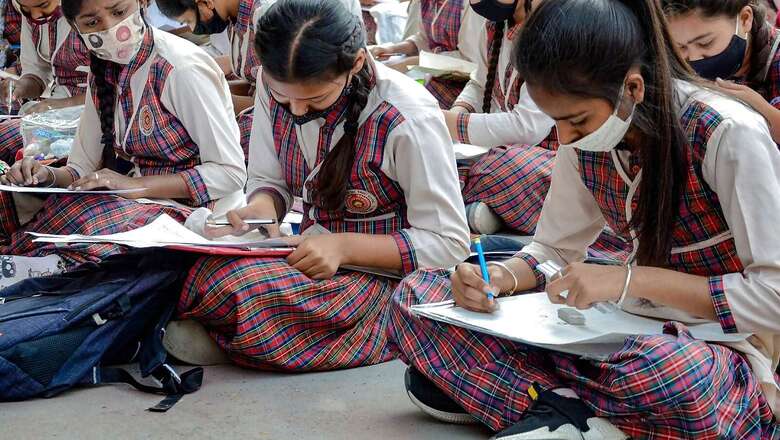
views
The National Credit Framework (NCrF) is a well thought out move of the Central government towards enhancing the employability of our students from their school days. It is in sync with the new National Education Policy-2020 (NEP-2020), which focuses on creating and facilitating a holistic and multi-disciplinary learning mechanism right from the primary to tertiary level. In view of the growing needs of employable human resources at different levels and in multiple sectors, a multi-modal entry and exit approach has been taken to develop a unified credit-based framework to create equivalence of credit levels across academics and vocational skills.
As is being claimed and what is being given to understand by the experts and other stakeholders, one can fairly presume that the credit framework will ensure seamless vertical mobility across academic and vocational education by converting learning into recognizable skills. Though not an easy task to be accomplished, I personally feel that the idea is viable and can be implemented well with the right kind of planning, which is fortunately not an issue in our country at the moment as Prime Minister Narendra Modi himself is very keen about empowering our children with some kind of employable skills.
Academic or course credits are points assigned to students typically based on duration and competencies required for the course. NCrF provides a way to measure and compare learning achievements and transfer them from one institution to another. The credit-based framework has been proposed in which Class V will be considered as Level 1, Class VIII as Level 2, Class X as Level 3 and Class XII as Level 4 in school education. For higher education programs, the credit level will increase by 0.5 for every year of learning. Hence, for four years of undergraduate course it will cover levels 4.5, 5.0, 5.5 and 6.0; and postgraduate courses will cover levels 6.0, 6.5 and 7.0; and a PhD will have the highest credit level 8.
As an industry expert, I can vouch for the fact that if this credit-based framework is made to see the light of the day as per the planning, India will become the largest exporter of trained human capital in the world by 2047, leapfrogging the economy to the multi-trillion US dollar bracket. In a country of 135 crore population and an overwhelming number of them being youngsters, imparting skills to all should constitute the kernel of all policies and programmes. The NCrF has been designed uniquely and is tuned to the needs of the present and the future as well.
The NCrF has five categories and each category has its own relevance. For example, there will be classroom teaching, laboratory and class projects. The other category consists of sports and games, yoga, physical activities, performing arts, music, crafts and bagless days. The third category is all about yearly or half-yearly examinations, class tests, quizzes, and assessments. The remaining two categories of great importance – vocational education and training, field visits, project work; and job training, internship, apprenticeship and experiential learning, which is today completely ignored.
As per NCrF, 1200 notional hours in an academic year have been assigned for higher education and vocational courses. Students will be awarded one credit for every 30 hours of learning. Hence, a student will get 40 credits in an academic year. This framework is applicable to both open and distance learning courses. To manage credits earned by students from the beginning of their school education, the Academic Bank of Credit (ABC) have been introduced under the DigiLocker framework, which will also include vocational education and training of the students.
Beyond this, students can also earn extra credits through additional upskilling vocational courses as micro-credentials, for maximum of 30 hours and to a minimum for 7.5 hours. The credit accumulation therefore would include skill training, experiential learning and academic education, and help in continuous learning and provide mobility to students as per the choice of his career. It is dynamic and full of positive possibilities. It is easy to implement as well. What is required is the whole government approach where all stakeholders come together to achieve – Mission Skill India.
However, I have my own fears though I am not a professional pessimist at all. It was way back in January 2015 when the Education Ministers of our states first endorsed the credit framework for skills and choice-based credit system. I remember the meeting was chaired by then Union Minister of Human Resource Development Smriti Zubin Irani and was attended by then Ministers of State for Human Resource Development Upendra Kushwaha and Prof Ram Shankar Katheria. Ministers from all the states endorsed the Credit Framework for Skills and the new Choice Based Credit System guidelines issued by the University Grants Commission. The conference was unanimous that adoption of the Credit Framework for Skills and the Choice Based Credit System is one of the best ways to bring about changes to meet student aspirations and employment needs. Unfortunately, there were deficiencies in our collective efforts to fill up the gap between our thought and action.
We need to understand that the Credit Framework for Skills also signals respect for skills and vocational courses in mainstream higher education, an initiative that will help change the mind set about vocational education being an inferior option. The Choice-Based Credit System opens up possibilities for students pursuing skills and courses of their choice to enhance their employability. We also need to tell our students about various scholarships and fellowships to peruse their education in India.
Our students do not know that Ministry of Education has introduced vocational degree and diploma programmes and courses to offer degree of bachelor of vocation and diploma of vocation in different sectors such as software development, electronics manufacturing services, graphics and multimedia, food processing, refrigeration and air conditioning, banking, financial services and insurance, production technology, industrial tool manufacturing and so on.
Much is not known about the fact that All India Council of Technical Education (AICTE) is implementing the Kaushal Augmentation and Restructuring Mission (KARMA) for school dropouts after class 10th for skill enhancement of the socially and financially deprived community of surrounding areas. Let’s join hands to realise the goal of Mission Skill India in a holistic manner!
The writer is co-founder and MD, Orane International, training partner with National Skill Development Corporation (NSDC), Network Member, India International Skills Centres, an initiative of GoI. The views expressed in this article are those of the author and do not represent the stand of this publication.
Read all the Latest Opinion News and Breaking News here















Comments
0 comment